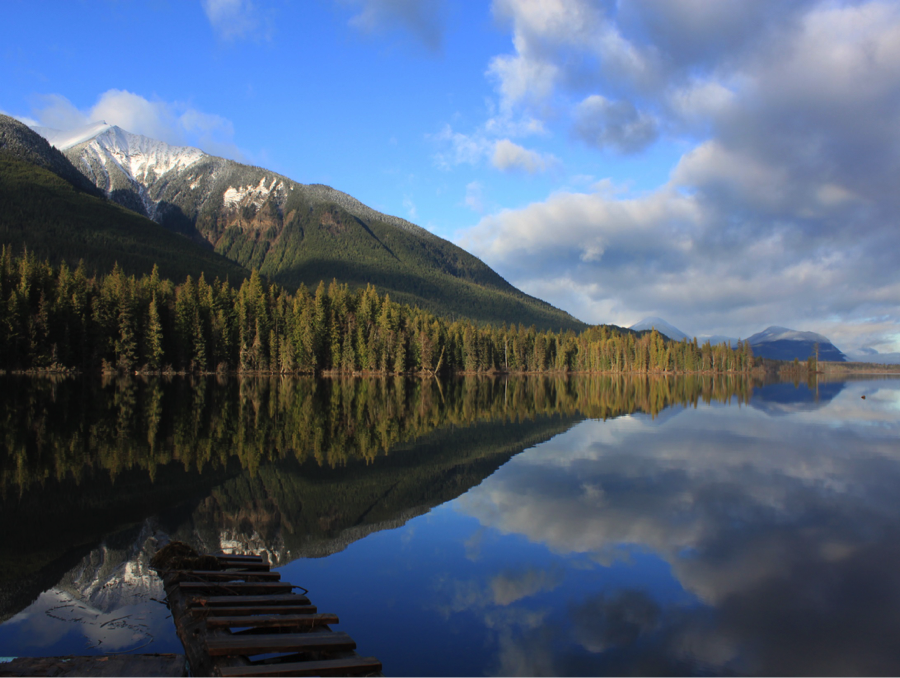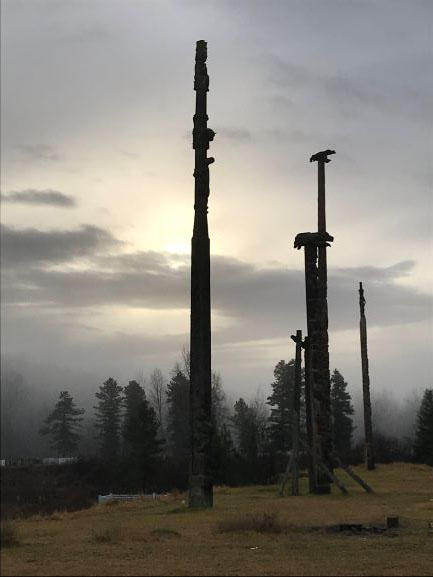
By Tara Marsden/Naxginkw and Gavin Smith
At the start of 2021, the Gitanyow publicly released the Gitanyow Wilp Sustainability Assessment Process (GWSAP), an innovative Indigenous legal instrument setting out requirements for fully Indigenous-led assessment of projects in Gitanyow Lax’yip (territory), based on Gitanyow’s own laws.
With the GWSAP, developed by Gitanyow in partnership with West Coast Environmental Law, Gitanyow is upholding its inherent jurisdiction and moving beyond the challenges experienced with Crown environmental assessments.
About the Gitanyow
The Gitanyow are an Indigenous people whose unceded Lax’yip is in what is now known as northwestern British Columbia, in both the Nass and Skeena River Watersheds. The Lax’yip is approximately 6,200 square kilometres and has a very low non-Indigenous population. Gitanyow, under the leadership of the Hereditary Chiefs, have never surrendered their Lax’yip through legal means, whether in Crown or Indigenous law.
The Gitanyow Nation comprises two Pdeek (Clans), organized into eight Wilp. The Wilp (plural: Huwilp) are the primary social, political and economic unit in Gitanyow society. Each Wilp owns and has authority over its respective Lax’yip.
The Lax’yip of the Gitanyow Huwilp has seen its fair share of historic and contemporary cumulative impacts from the forestry, mining and hydro-electric power industries. The Gitanyow Hereditary Chiefs, as stewards of their collective Wilp territories, have taken a bold new step towards re-claiming their ancestral stewardship rights through the development of the Gitanyow Wilp Sustainability Assessment Process. The GWSAP is based in the foundation of the Gitanyow Ayookxw (Gitanyow’s Indigenous Laws) and the development of modern legal and policy instruments including the Gitanyow Lax’yip Land Use Plan, Gitanyow Cultural Heritage Policy, and the soon-to-be-complete Gitanyow Water Law.
The need for the Gitanyow Wilp Sustainability Assessment Process
For Gitanyow, the concept of Gwelx ye’enst has always been the main driver in the approach to lands and resources, in the face of colonial imposition and environmental degradation. Gwelx ye’enst is the right and responsibility to pass on the Lax’yip in a sustainable manner from one generation to another. It has guided the work of the Gitanyow Hereditary Chiefs for millennia, and finds its expression in the newly developed GWSAP.
Having participated in several Crown-led environmental assessments over the past 10 years, the Gitanyow Chiefs came to realize that these provincial and federal processes were not about sustainability. Gitanyow President and Hereditary Chief Malii/Glen Williams states:
“No matter what the project is, or where it is located, the end result is always the same – no significant adverse effects. Government environmental assessments are about finding ways to mitigate impacts, not about ensuring sustainability or having a real yes or no decision – is the project in our best interests?”
For many First Nations in BC, the environmental assessment process has been a source of frustration and unmet objectives around conservation, sustainable development, and respect for constitutional Aboriginal rights. In fact, a large proportion of court cases brought forward by First Nations are the result of disagreement in environmental assessments.
While pursuing legal action or land-based action on a case-by-case basis has yielded some positive results, it is not a long-term solution. Developing Indigenous-led processes, based in sound science, Indigenous laws, and defensible sustainability principles has been a long-standing aspiration for Gitanyow and many other nations in BC.
What the Gitanyow Wilp Sustainability Assessment Process accomplishes
The Gitanyow Ayookxw for Wilp Sustainability Assessment is the name of the law brought into force by the Gitanyow Hereditary Chiefs, through the inherent jurisdiction of the Gitanyow Huwilp and pursuant to the Gitanyow Constitution, to establish the assessment process. The GWSAP aims to protect and restore the Gitanyow Lax’yip for present and future generations, and upholds the decision-making authority of each Wilp to determine what activities are permitted in their respective Lax’yip.
The GWSAP requires all actors (e.g. companies, Crown governments) to follow Gitanyow strategic direction, such as the Gitanyow Lax’yip Land Use Plan, and prohibits proposed projects from accessing the Lax’yip without the consent of the impacted Wilp. The GWSAP sets out Gitanyow’s own process for assessing new projects, and also provides for Gitanyow monitoring, assessment and response for past and ongoing impacts on the Lax’yip.
Everything in the GWSAP is Gitanyow-led in order to uphold the Ayookxw (Gitanyow law), ensure Wilp sustainability, and inform the decisions of impacted Wilp about whether to grant free, prior and informed consent.
 The Crown must respect Gitanyow law
The Crown must respect Gitanyow law
While Gitanyow has attempted to reach some form of long-term settlement agreement with the Crown, the treaty model has been rejected by the Gitanyow and other interim reconciliation agreements have been sought instead.
In 2012, the Gitanyow and the Province of BC signed the Gitanyow Huwilp Recognition and Reconciliation Agreement, which included the comprehensive Gitanyow Lax’yip Land Use Plan. This was renewed in 2016, and negotiations are underway currently to update and enhance the existing reconciliation agreement.
Within the current agreement, Schedule H commits BC and the Gitanyow to “negotiate and attempt to reach agreement on a framework, principles and approach for project-specific wilp sustainability assessments”. This Crown recognition, together with the commitment in BC’s new Environmental Assessment Act to uphold the United Nations Declaration on the Rights of Indigenous Peoples, is the foundation for Gitanyow’s expectation that the GWSAP will be respected by the Crown and run in parallel to provincial environmental assessments.
Forging a new path
The GWSAP is truly a departure from the status quo, based in a strong foundation of Indigenous laws and traditions, sound science, and reconciliation with Crown governments. Despite colonization and the repeated attempts to erase Indigenous peoples and our laws from the lands in BC, we have persisted and are working in earnest to face the challenges of climate change, species loss, and cumulative impacts. With support and allyship from organizations such as West Coast Environmental Law, Gitanyow has been able to develop new modern legal instruments that express and uphold ancestral principles of sustainability.
Tara Marsden is a Gitanyow Wilp member, and worked for close to 10 years as Wilp Sustainability Director for the Gitanyow Hereditary Chiefs. Currently, Tara is a part-time contractor with Gitanyow, and also serves as the Senior Indigenous Advisor for the Healthy Watersheds Initiative. Tara has worked closely with West Coast Environmental Law over the past few years to help develop the GWSAP under the direction of the Gitanyow Hereditary Chiefs.
This article is co-written in recognition of the allyship of West Coast Environmental Law in the long-standing support of Gitanyow’s rights and title.
Gavin Smith is a staff lawyer at West Coast Environmental Law living in Gidimt’en Clan territory of the Witsuwit’en Nation in Smithers, BC. Through the RELAW program, Gavin and WCEL Executive Director and Senior Counsel Jessica Clogg have provided multi-year support to the Gitanyow in creating and implementing the GWSAP.
West Coast gratefully acknowledges the Law Foundation of British Columbia, the Gordon and Betty Moore Foundation, Swift Foundation and Patagonia for their financial support of this work through our RELAW program.